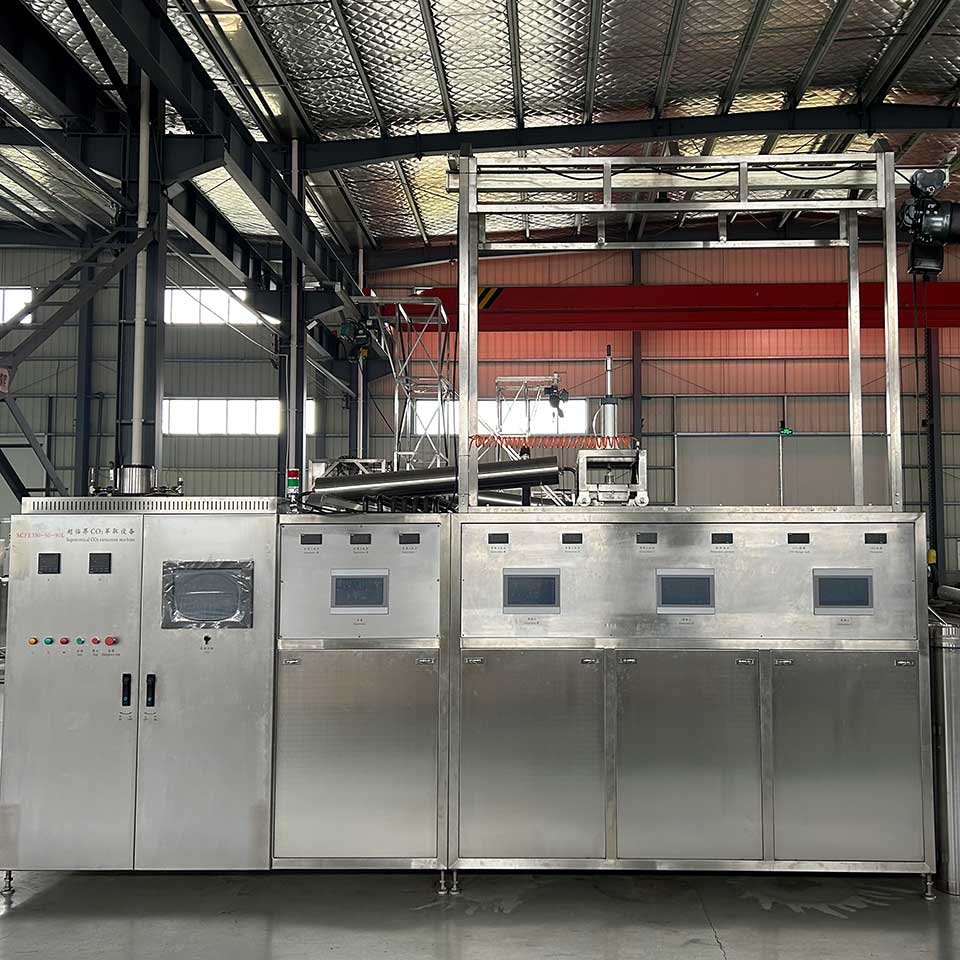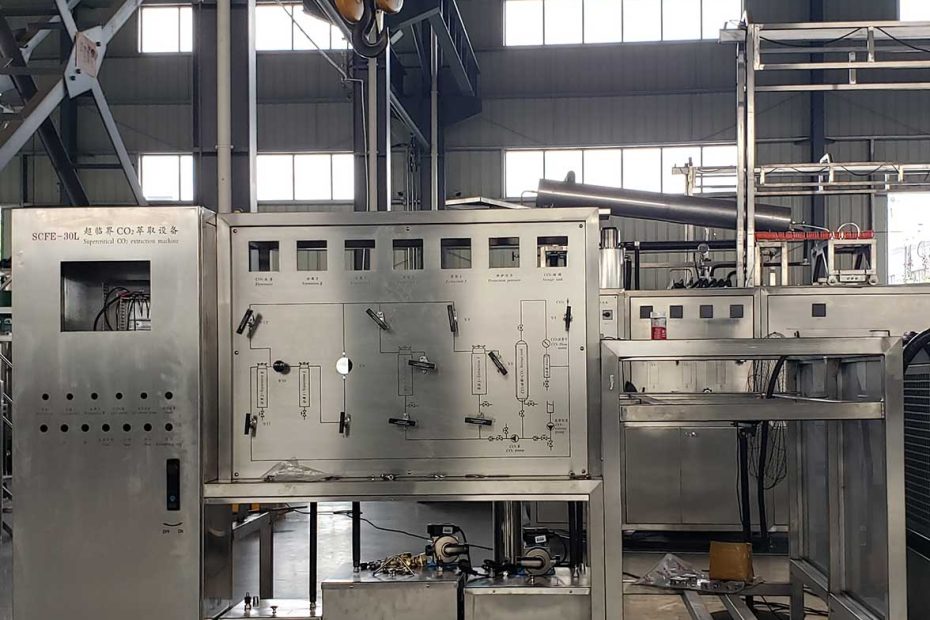The extraction kettle is a key equipment in supercritical fluid extraction technology. Due to the high operating pressure, its manufacturing cost has increased significantly. Therefore, a new extraction tank with reasonable structure, simple manufacturing, convenient use, safety and low cost has been developed. The kettle is of great significance to accelerating the industrialization of supercritical fluid extraction technology.
Structure and Function of Supercritical Fluid Extraction Kettle
The supercritical fluid extraction kettle is a specialized vessel designed to withstand high pressures and temperatures required for the SFE process. It typically consists of the following components:
- Pressure Vessel: The main body of the kettle is a robust pressure vessel capable of withstanding pressures well above the critical point of the supercritical fluid.
- Heating and Cooling Systems: These systems control the temperature within the kettle, allowing precise regulation of the extraction conditions.
- Extraction Chamber: This is the part of the kettle where the material to be extracted is placed. It is designed to ensure efficient contact between the supercritical fluid and the material.
- Pressure Control Mechanism: The kettle includes mechanisms to precisely control the pressure, crucial for maintaining the supercritical state of the fluid.
Six basic requirements for the design and manufacture of extraction kettles
The operating pressure of supercritical fluid extraction is generally 7-35Mpa, and some can reach more than 100 MPa, but they are often subject to alternating loads. Therefore, in addition to meeting the requirements of general high-pressure vessels, high-pressure vessels for supercritical fluid extraction of solid materials also The following special requirements need to be met.
Meet the requirements of health regulations
Supercritical fluid is used to extract solutes from solids, which is often used in food, medicine, cosmetics and other industries. The equipment should meet various health regulations for food and medicine production.
There is a quick opening and closing device
The intermittent operation of the supercritical fluid extraction kettle requires frequent material replacement operations, and it takes a lot of time to open and close the top lid of the container. Therefore, the use of a quick opening and closing device can reduce operating time and improve production efficiency.
Quick-opening capping devices are mostly used in medium and low-pressure vessels. Supercritical CO2 fluid extraction requires quick-opening capping devices to be used in high-pressure or even ultra-high-pressure vessels. At present, many high-pressure vessels in China have adopted quick-opening lid devices. For example, food puffing kettles adopt a toothed structure, which makes.The supercritical fluid extraction kettle adopts a clamp structure.
Good fatigue resistance
When a pressure vessel is subjected to alternating loads, fatigue failure is likely to occur in high-strain areas where plastic strain occurs, such as the root of the nozzle. my country’s fatigue design regulations stipulate that the overall part of the container shall not bear alternating loads more than 1,000 times, and the non-integral parts shall not bear more than 400 times.
No fatigue analysis is required. For an intermittent operation supercritical fluid extraction kettle, each extraction cycle is generally 2 to 3 hours. Calculated based on 300 days a year, the pressure needs to be increased and reduced 2,400 times. For example, based on a 15-year life, the extraction kettle can withstand an alternating load of 36,000 times. times, it has already exceeded the above regulations. Therefore, the extraction kettle is required to have good fatigue resistance.
Temperature control is easy
The operating temperature has a great influence on the solubility of supercritical fluids, and endothermic or exothermic phenomena often occur during the extraction process, destroying the temperature balance in the extraction kettle. Therefore, it is required in supercritical fluid extraction. The temperature is well controlled. At present, in most cases, clamping
The method of flowing circulating water into the jacket is to ensure a constant temperature in the extraction kettle. This method is simple and easy but the effect is not good. There is also a method of grooving the outer surface of the inner cylinder of the multi-layer container and then passing the circulating water through it. This method is used This method can reduce heat transfer resistance and increase the temperature in the extraction kettle
Control effect, but the structure is complex, easy to block, and the flow of circulating water is limited; it is also possible to place bent pipes such as coiled pipes in the extraction kettle to achieve the purpose of temperature control, but it is limited by the operating process and is often used in many cases. This approach cannot be used.
Compact structure and low cost
When designing the extraction kettle, the container should be as compact as possible, easy to manufacture, and low in production cost on the premise of meeting the strength. If the hemispherical head and the cylinder are connected with equal thickness, it will waste material and appear bulky. If unequal thickness connections are used, steel can be saved and manufacturing costs can be reduced, but problems such as stress concentration caused by discontinuous structures at the connections need to be solved.
Safety protection device
It can prevent accidents caused by misoperation.
In terms of temperature control of the extraction kettle, constant temperature circulating water can be passed through the jacket to ensure a constant temperature in the extraction kettle.
Since the temperature of the supercritical fluid and materials has reached the operating temperature before entering the extraction kettle, relatively speaking, the temperature changes caused by the extraction operation are not as obvious as those caused by supercritical chemical reactions. Therefore, the use of jackets and constant temperature water bath devices can fulfil requirements.

6 major features of supercritical fluid extraction kettle
- The unequal thickness connection structure between the cylinder and the hemispherical head is adopted, so that the wall thickness of the hemispherical head can be reduced by nearly 1/2. This not only reduces the weight of the container, but also makes the hemispherical head easier to manufacture and process. More convenient and lower cost
- The use of reinforcing hoops in the connection structure can reduce the application concentration coefficient of the connection and improve the stress state of the cylinder and head near the connection;
- Since there is no need to loosen or tighten the fastening bolts during the container opening and closing process, and the extraction kettle can be opened and closed by simply rotating the kettle lid at a certain angle, the operation time is short and the material loading and unloading is very convenient.
- The quick-opening device is equipped with a safety interlock device, which can automatically control the opening and closing action of the end cover so that the container cannot be pressurized before the end cover is completely closed; when the pressure is not completely released, the locking device cannot release. In this way, the container itself has the ability to prevent accidents caused by misoperation.
- There is a jacket outside the cylinder. During operation, constant temperature water can be added to ensure that the operating temperature of the extraction kettle remains basically unchanged.
Conclusion
The supercritical fluid extraction kettle represents a vital component in the field of supercritical fluid extraction, a revolutionary technology with applications spanning pharmaceuticals, food, cosmetics, and environmental remediation.
With its ability to selectively and efficiently extract valuable compounds while minimizing environmental impact, this technology is poised to play an increasingly significant role in various industries. As research and innovation continue, the potential of supercritical fluid extraction kettles to enhance extraction processes and advance scientific discovery remains a promising avenue for the future.
